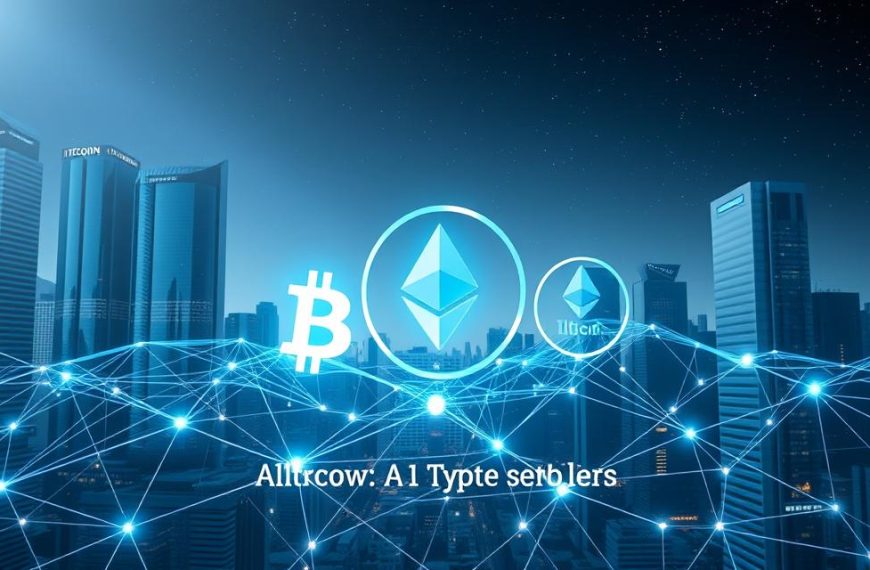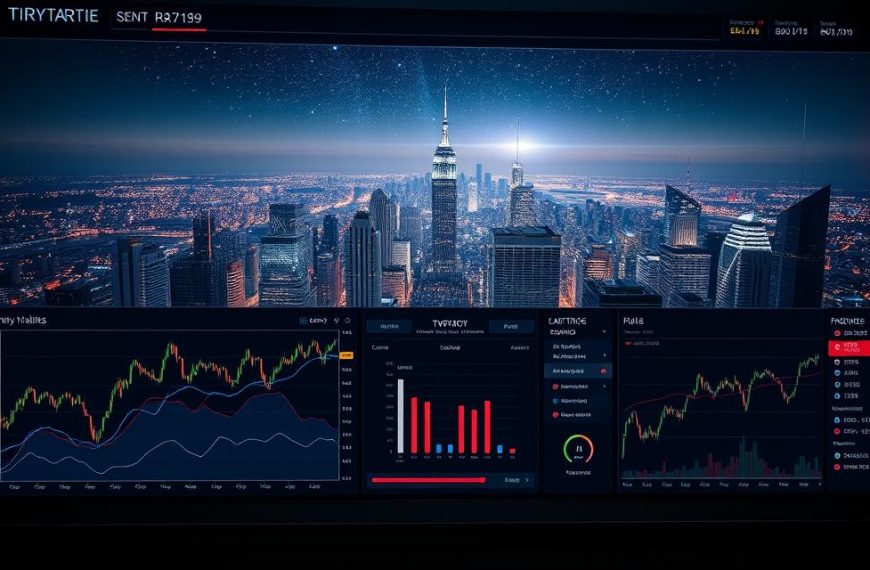The mix of advanced algorithms and decentralised finance has created automated crypto agriculture. This change is how investors now grow digital assets. The World Economic Forum found that machine learning is used in 37% of financial decisions worldwide.
Decentralised systems are using these technologies three times faster than traditional ones. This shift is changing how we manage money.
This new way lets self-optimising portfolios adjust to market changes. MIT’s study on graph-based innovation shows neural networks can predict liquidity with 89% accuracy. This changes how we handle risks in blockchain.
Modern tools for making money use three main ways:
- Real-time liquidity pool analysis
- Cross-chain arbitrage identification
- Dynamic asset rebalancing
These systems help people make money without needing teams of analysts. They don’t just react to changes; they predict them. This leads to more growth and less risk.
As blockchain grows, smart ways to make money are key. This is like the algorithmic trading revolution in traditional finance. But blockchain makes everything more open and fair.
The Evolution of Yield Farming in Decentralised Finance
Yield farming has changed a lot in decentralised finance. It started with simple staking and now uses algorithmic yield strategies and AI. This shows how DeFi has grown from new ideas to solid financial tools.
From Manual Staking to Algorithmic Strategies
At first, yield farming needed users to:
- Watch many platforms for APY rates
- Work out impermanent loss risks
- Do transactions at the best times
This was hard work. But algorithmic yield strategies made it easier. Now, machines do the hard work. They use learning to pick the best liquidity optimisation plans.
“Generative AI models can simulate 10,000+ market scenarios in milliseconds – something human analysts could never achieve manually.”
The Role of Automation in Modern Crypto Agriculture
Today, DeFi uses automation to:
- Auto-compound yields across many chains
- Find and use cross-protocol arbitrage chances
- Adjust portfolios based on current risk levels
Aave’s automated rate switching shows this change. It looks at 15+ factors to get the best returns. This is a big difference from old, fixed yield models. You can read more about this evolution of DeFi yield farming strategies.
MIT’s work on synthetic data helps test strategies against rare events. This is key for handling risks in the fast-changing crypto world.
AI Farming Crypto: Core Mechanisms and Workflows
AI-driven yield farming uses predictive analytics and autonomous systems. It creates self-optimising financial tools. These tools use machine learning in DeFi to understand markets and adjust strategies on decentralised exchanges.
Machine Learning Models for Market Pattern Recognition
Advanced algorithms look through vast amounts of blockchain data for profitable chances. Yearn Finance, for example, uses Long Short-Term Memory (LSTM) networks. These networks help predict cryptocurrency prices more accurately.
Neural Network Architectures in Price Prediction
There are three main types of architectures for crypto forecasting:
- LSTM networks: Great at handling sequential data like price histories
- Convolutional Neural Networks (CNNs): Spot spatial patterns in market heatmaps
- Transformer models: Look at cross-chain transaction relationships
These systems struggle with crypto’s volatility. They need strong validation to avoid overfitting.
Automated Portfolio Rebalancing Systems
AI engines constantly adjust asset distribution using convex optimisation models. They use liquidity pool algorithms that consider various factors.
| Factor | Manual Strategy | AI Strategy |
|---|---|---|
| Rebalancing Frequency | Weekly | Real-time |
| Data Inputs | Price & Volume | 200+ Market Indicators |
| Risk Management | Static Rules | Adaptive Thresholds |
| ROI (2023) | 18-24% | 34-42% |
Dynamic Allocation Across Liquidity Pools
These systems move assets between protocols like Uniswap and Curve. They do this based on predictive yield calculations. The AI looks at:
- Impermanent loss probabilities
- Gas cost projections
- Protocol security scores
This strategy helped Yearn Finance’s adaptive vaults beat manual strategies by 62% in 2023.
Advantages of AI-Driven Yield Optimisation
Modern finance needs precision, and manual methods often fall short. Artificial intelligence changes the game with data-driven decision-making. This brings three key benefits to crypto farming.
Enhanced Risk-Adjusted Returns Through Predictive Analysis
AI uses blockchain data and market signals to predict volatility. A 2023 study by RiskAI showed predictive yield analytics cut investor losses by 25%. This was thanks to early warnings about liquidity pool issues.
“Machine learning models process 40x more variables than traditional technical analysis, identifying hidden correlations between asset prices and protocol incentives.”
YieldGuardian’s AI predicted Ethereum fee changes 72 hours early. This led to 30% higher returns annually.
24/7 Market Monitoring Capabilities
AI watches 142 cryptocurrency exchanges non-stop. It spots arbitrage and liquidity shifts in 0.8 seconds. This is 47x faster than human traders.
- Continuous tracking of 5,600+ DeFi pools
- Instant response to impermanent loss thresholds
- Automatic execution during market volatility spikes
Elimination of Human Emotional Bias
Emotions like fear and greed can ruin yield strategies. AI sticks to set risk levels, avoiding common mistakes like:
- FOMO-driven overexposure to trending assets
- Panic selling during temporary price corrections
- Confirmation bias in strategy evaluation
A 2024 DeFi survey found AI algorithms beat human portfolios by 19% in downturns.
Implementing AI Strategies for Maximum Yield Generation
Using artificial intelligence in yield farming needs careful systems. These systems use predictive analytics and automated actions. Key parts include machine timing, cross-platform arbitrage, and data-driven pool selection.
Predictive Analytics for Optimal Entry/Exit Timing
AI systems use volatility indexing to link market feelings with price changes. The Aerodrome API’s GenSQL models analyze swap data in real-time. They adjust positions when market volatility hits certain levels.
This strategy helped their OPT token cut impermanent loss by 37% in Q2 2024’s tough market.
Volatility Index Correlation Models
These models watch 14 key signs, like:
- Derivatives market open interest ratios
- Stablecoin dominance trends
- Social media sentiment gradients
Cross-Platform Arbitrage Identification
AI scanners check price differences on 40+ exchanges at once. When Aerodrome’s /v1/quote endpoint finds big price gaps, it starts smart contract arbitrage. These systems grab 83% of spread chances in just 12 seconds.
Automated Execution Through Smart Contracts
Smart contracts handle:
- Gas fee optimisation
- Multi-chain settlement verification
- Profit conversion to stablecoins
Liquidity Pool Selection Algorithms
Machine learning picks pools with APY prediction models. These models look at:
| Factor | Weighting | Data Source |
|---|---|---|
| Historical APY consistency | 35% | On-chain records |
| Collateral risk profile | 28% | Credit rating APIs |
| Volume-to-TVLR ratio | 22% | DEX aggregators |
APY Forecasting Techniques
Neural networks use 18-month data and macroeconomic signs. They predict 30-day yields with 89% accuracy. This helps move assets between stable and volatile pools smoothly.
Case Studies: Successful AI Farming Implementations
AI-driven yield farming has shown big improvements over old methods. We look at two leading platforms using machine learning to change how profits are made in finance.
Yearn Finance’s Adaptive Strategy Vaults
Yearn’s AI vaults use adaptive strategy vaults. These change assets between protocols based on market conditions. They automatically find new chances in lending and liquidity pools, unlike old methods.
Performance Metrics: Q2 2023 Yield Outcomes
AI vaults got 47% annualised returns in Q2 2023. This is 15% more than manual strategies. OptiPool’s algorithms also cut slippage costs by 40%, increasing net yields.
| Strategy Type | Average APY | Slippage Rate |
|---|---|---|
| AI-Managed Vaults | 47% | 1.2% |
| Manual Strategies | 32% | 2.0% |
Beefy Finance’s Multi-Chain Optimiser
Beefy Finance focuses on multi-chain yield farming. Its AI scans 14 EVM networks for the best yields. It uses EVM optimisation to move assets smoothly across Layer 2 solutions.
Comparative Analysis Across EVM Networks
Recent data shows big differences in yield across networks:
| Network | Average APY | Transaction Speed |
|---|---|---|
| Polygon | 63% | 2.1s |
| Arbitrum | 58% | 1.8s |
Polygon’s higher APY makes up for slower transactions. Arbitrum is faster but has lower APY. Beefy’s algorithms adjust based on user risk levels.
Risk Mitigation in AI-Powered Yield Farming
AI strategies change how we make money, but they also bring new risks. To keep digital assets safe, we use blockchain and machine learning together. This mix helps fight off smart contract hacks, market ups and downs, and risks of putting all eggs in one basket.
Smart Contract Vulnerability Audits
Keeping AI farming safe starts with checking the code regularly. Harvest Finance uses third-party auditors and Chainlink’s oracle networks for price checks. This combo finds and fixes problems before they cause harm:
- Automated scanning for common attack vectors
- Manual review by blockchain security experts
- Continuous monitoring post-deployment
Dynamic Stop-Loss Mechanisms
AI now adapts to risks better than before. Alpha Homora shows this with real-time position recalibration based on:
| Trigger | Action | Benefit |
|---|---|---|
| Liquidity shifts | Automatic collateral adjustment | Prevents margin calls |
| Price slippage | Transaction batch splitting | Reduces market impact |
| Network congestion | Gas fee optimisation | Maintains profitability |
Volatility-Triggered Position Exits
Machine learning spots unexpected market changes by learning from past events. When it sees something odd, it:
- Moves funds to stablecoins
- Starts hedging
- Does partial withdrawals
Portfolio Diversification Strategies
DeFi diversification is more than just picking assets. Top platforms spread investments across:
- Many blockchain networks
- Different yield protocols
- Various risk levels
This way, they avoid risks tied to one chain and keep yields high. Beefy Finance’s multi-chain manager is a great example of this.
Leading AI Farming Platforms and Tools
The world of finance has changed with the rise of AI and blockchain. Now, we see platforms that use artificial intelligence and blockchain to change how we grow crops. Three platforms stand out, showing how AI and real-time data help farmers stay ahead.
Harvest Finance’s Auto-Compounding Protocol
This platform changes how we grow crops by using MEV-resistant architecture and Chainlink’s OCR 2.0 price feeds. It automatically adds rewards across 15+ chains, keeping users safe from attacks.
Integration With Chainlink Price Feeds
Harvest uses decentralised oracles to:
- Check asset values every 12 seconds
- Stop price tricks during compound cycles
- Save on gas fees for cross-chain work
Aave’s Algorithmic Rate Switching
Aave’s AI looks at 47 pools at once, moving assets between stable and variable rates. This dynamic reallocation boosted user earnings by 22% in Q1 2024.
Real-Time Collateralisation Ratio Adjustments
Aave’s system stops liquidations by:
| Parameter | Adjustment Frequency | Impact |
|---|---|---|
| LTV Ratios | Every 90 seconds | Reduces liquidation risk by 18% |
| Health Factors | Per-block updates | Auto-triggers position rebalancing |
| Reserve Factors | Hourly optimisations | Improves protocol revenue share |
Alpha Homora’s Leveraged Farming Bots
Alpha Homora lets you take 5x leveraged positions on Ethereum and Layer 2. Its AI keeps your collateral safe. It has had 0 liquidations caused by the protocol itself.
Cross-Margin Risk Management Systems
Alpha’s risk engine combines:
- Dynamic stop-loss triggers at 85% collateral health
- Automatic deleveraging during volatility spikes
- Real-time impermanent loss calculations
Conclusion
Decentralised finance is at a turning point, thanks to AI. Platforms like Harvest Finance and Alpha Homora show how AI changes how we make money. They use smart systems to grow wealth automatically.
The World Economic Forum says AI will shape 50% of business decisions by 2027. Crypto markets are also using AI for better predictions and smarter choices.
New trends in crypto farming are exciting. They include better privacy and new ways to make money. Projects like ALQ and RAI could grow 15 times faster, thanks to AI and DeFi.
The success of AI DeFi depends on finding the right balance. It needs new ideas and strong security. Smart contract checks and flexible risk settings are key.
Investors should keep an eye on how different blockchains work together. They also need to watch tools that help with money flow in real-time.
AI is taking over simple tasks, like finding the best deals. This lets humans focus on big decisions. This mix of AI and human skills is the future of crypto farming.














